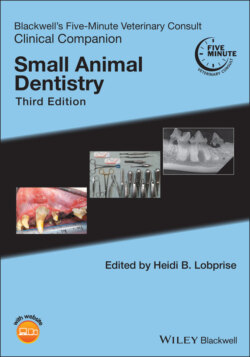Читать книгу Blackwell's Five-Minute Veterinary Consult Clinical Companion - Группа авторов - Страница 27
Additional Considerations
ОглавлениеPre‐extraction (see Chapter 7)Ensure the mandibles and symphysis are intact and have sufficient bone supporting prior to extraction.Check for root dilaceration and resorption.
Tooth resorption (TR): primarily cats, but also dogs (see Chapter 40).The decision on the methods of extraction in the case of TR is dependent on the visibility of the periodontal ligament.A focal lucency with visible PDL represents inflammatory (type 1) TR requiring traditional elevation to extract the tooth and its root (Figure 3.38).A ghosting appearance of the tooth root in which the PDL is not discernible is replacement resorption (type 2) (Figure 3.39). A modified extraction technique (MET) in which the crown is amputated to the level of alveolar bone and the area smoothed with a diamond bur is indicated. This results with intentional root retention (IRR). Follow‐up with annual radiographs is necessary to ensure the replacement resorption completes so that the retained portion is indistinguishable from alveolar bone.Removal of retained tooth root pieces using a high‐speed bur through root pulverization is contraindicated. Root pulverization is known to result in bone necrosis, air embolism, and sublingual/subcutaneous emphysema [4].Root resorption (common in dogs) (Figure 3.40)When resorption occurs on the external surface and involves only the tooth root but not the neck or crown of the tooth, as is commonly seen in large‐breed dogs, no treatment is needed. Annual anesthetic preventive dental procedures with intraoral radiographs are needed for monitoring. If the resorption extends to the neck or crown of the tooth, and has access to the oral cavity or gingival sulcus, it is painful requiring extraction.
Trauma (see Chapters 37 and 38)Intraoral films can target specific areas of traumatic damage.Sometimes, full skull radiographs give a broader picture of the extent of damage.Figure 3.38 Some teeth that appear to have classic resorptive lesions display no odontoclastic activity (no replacement resorption) on radiographs. These teeth are more periodontally involved, with root exposure due to attachment loss (gingiva and bone loss) and subsequent erosion of the exposed portion of the root, but the submerged root remains intact, along with a distinct periodontal ligament space.Figure 3.39 Odontoclastic lesions (replacement resorption) of feline teeth need to be assessed radiographically. Often seen is the presence of root resorption with indistinguishable root, periodontal ligament space, and alveolar bone.Patients with trauma have 1.6–2 times more injuries as noted by CT which are missed with conventional radiology [8]. That is an average of three injuries per patient missed when three‐dimensional imaging is not utilized.
NeoplasiaAny suspicious lesion should be radiographed and biopsied (Figure 3.41).Be cautious with gingival enlargement: many benign‐looking changes are actually invasive painful growths, while not all show radiographic changes (Figure 3.42). All types of oral biopsies should be sent to an oral pathologist† for more definitive identification.Figure 3.40 When resorption is on the external surface and involving only the tooth root but not the neck or crown of the tooth, as seen here in a dog, no treatment is needed. If the resorption extends to the neck or crown of the tooth, and has access to the oral cavity, it is painful requiring extraction.Figure 3.41 Radiographs may give an indication as to the severity of oral masses, particularly their osseous involvement, as in this aggressive squamous cell carcinoma in a feline mandible.Figure 3.42 (a) Presumed gingival enlargement and periodontal disease. (b) Four months later, the mass effect has become apparent. Radiographic signs of neoplasia were not present on initial presentation. Other cases may progress much faster than four months.While conventional radiographs are fine (80% accurate) at detecting bone invasion with maxillary masses, they are three times less sensitive than CBCT in detecting invasion of adjacent structures, an important prognostic indicator [11].
Post‐procedure: it is essential to have pre‐ and post‐extraction radiographs [2]. A study of reported complete carnassial extractions in dogs and cats showed that tooth fragments remained in place 82–92% of the time [1].
